If you are not familiar with the concept of attributes, you can read the What is an attribute? article.
How to create an attribute?
Akeneo proposes several types of attributes. Discover all attributes available in the Introduction to Akeneo attribute types article. Make sure you pick the most appropriate attribute type that perfectly matches your needs.
For example, if you want to make sure that your PIM users will select one option from a list of predefined options, select a simple select attribute type instead of a free text field. Create a metric attribute to add a weight/size/length... for your products.
To create an attribute in Akeneo PIM:
- Go to Settings/Attributes
- Click on the Create attribute button:
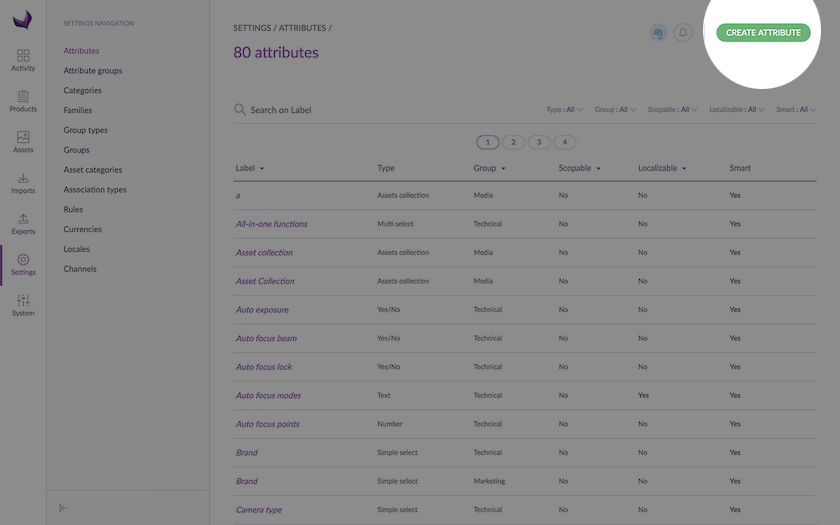
- Select the attribute type you want:
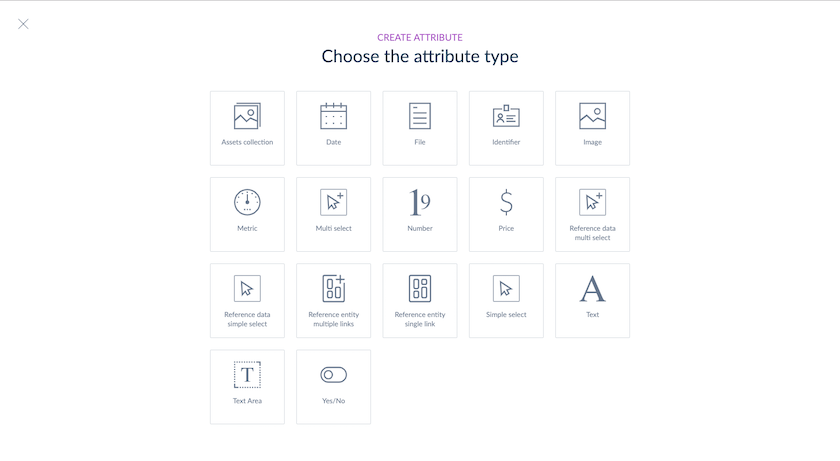
- The attribute edit form is displayed, fill in the following properties:
Under General Parameters:- A code (required) to identify the attribute.
- A type based on the attribute type selected in the previous screen.
- An attribute group (required) to which the new attribute will be added.
- In addition to these required attributes, you can select the following properties:
- Unique value (Yes/No): enable this property if the value of this attribute must be unique. By default, it is set to yes for Identifier attribute type.
- Value per channel (Yes/No): enable this property if you plan to have different product values per channel.
- Value per locale (Yes/No): enable this property if you plan to have different product values per locale.
- Read only (Yes/No) (Enterprise Edition only): to prevent this attribute from being edited through the UI, it will only be updated through imports, API or rules
- Usable in grid (Yes/No): if you want to filter on this attribute in the product grid or use it as a column.
-
Locale specific: this attribute will only be available for some locales.
Under Validation Parameters, add validations to control your data: - Validation parameters: each attribute comes with validation parameters (see Add attributes validation parameters).
- Click on Save to create your attribute.
Please note that the following attribute codes cannot be used in Akeneo PIM:
id, ID,identifier, Identifier, associationTypes, category, categories, categoryId, completeness, enabled, family, Family, *_groups, associations, *_products, scope, treeId, values, label, LABEL, Label, parent. We strongly recommend you not to use any of these codes even if the letter case is different, for instance Id, Groups.
Some attribute properties cannot be edited afterwards, such as code, unique value, value per channel and value per locale make sure they fit your needs!
Add attributes validation parameters
Each attribute has specific properties to add more control on attribute's values:
-
Date attribute:
- Min date: the earliest date that can be accepted
- Max date: the latest date that can be accepted
-
Text attribute:
- Maximum number of characters: maximum number of characters that an attribute value can have
- Validation rule: how the value should be validated: such as an URL, as an Email, or using a regular expression
-
Text area attribute:
- Maximum number of characters: maximum number of characters that an attribute value can have
- Enable WYSIWYG: activates the WYSIWYG feature
-
File attribute and image attribute:
- Maximum size allowed in MB
- Allowed extensions files
-
Metric attribute:
- Allow negative values for the attribute
- Allow decimal values for this attribute
- Minimum value: the smallest value allowed
- Maximum value: the largest value allowed
- Metric family: family measurement unit to be used for the attribute (weight, dimensions, area, etc. )
- The default unit of measurement
-
Price attribute:
- Allow decimals for the attribute values
- minimum value: the smallest allowed value
- maximum value: the largest allowed value
-
Number attribute:
- Allow negative values for the attribute
- Allow decimals
- Minimum value: the smallest allowed value
- Maximum value: the largest allowed value
-
Reference entity single link attribute & reference entity multiple links attribute (Enterprise Edition only):
- Related reference entity: the reference entity linked to this attribute
-
Reference data simple select attribute & reference data multi select:
- Reference data type: choose an existing reference data value to link to your attribute
-
Asset collection attribute (Enterprise Edition only):
- Related asset family: the asset family linked to this attribute
-
Table attribute (Enterprise and Growth Editions only): depending on your column types, there can be several validation parameters:
- text column type: Maximum number of characters (it must be less than 100 characters)
-
number column type:
- Allow decimals
- Minimum value: the smallest allowed value
- Maximum value: the largest allowed value
For the text attribute type, you can add a regular expression to validate the content of the input. For instance, to control the right format of a EAN13 code, add a validation rule based on the following regular expression: /^[0-9]{13}$/
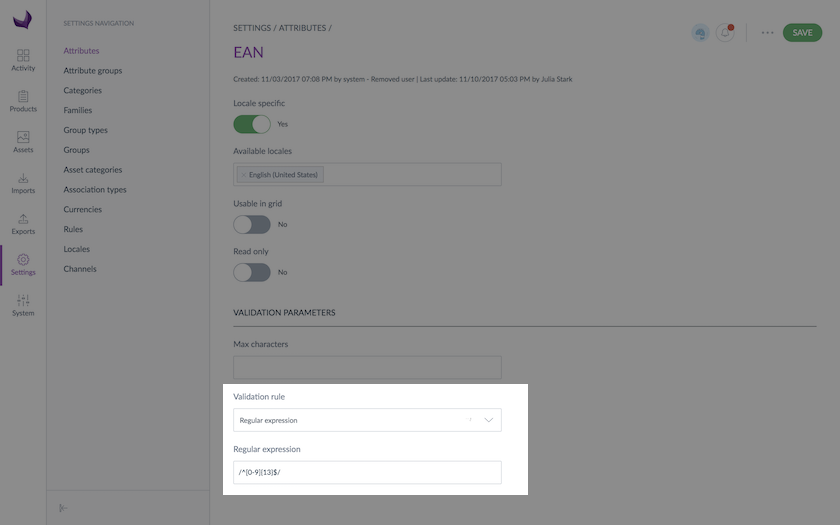
The simple and multi select attribute types, as well as Yes/No (boolean) attribute have no specific validation properties.
Translate your attribute labels
Once your attribute is created, translate it! You can add a translation for each enabled locales under the Label translations tab. If you need to edit some other attribute's property, please refer to the section Edit attribute properties.
Simple and multi select attribute types rarely need to be localisable since all their options can be translated in any enabled locales in the PIM.
Edit attribute properties
To edit an attribute:
- Go to Settings/Attributes
- Select the attribute to edit in the grid and click on the line or on the edition shortcut
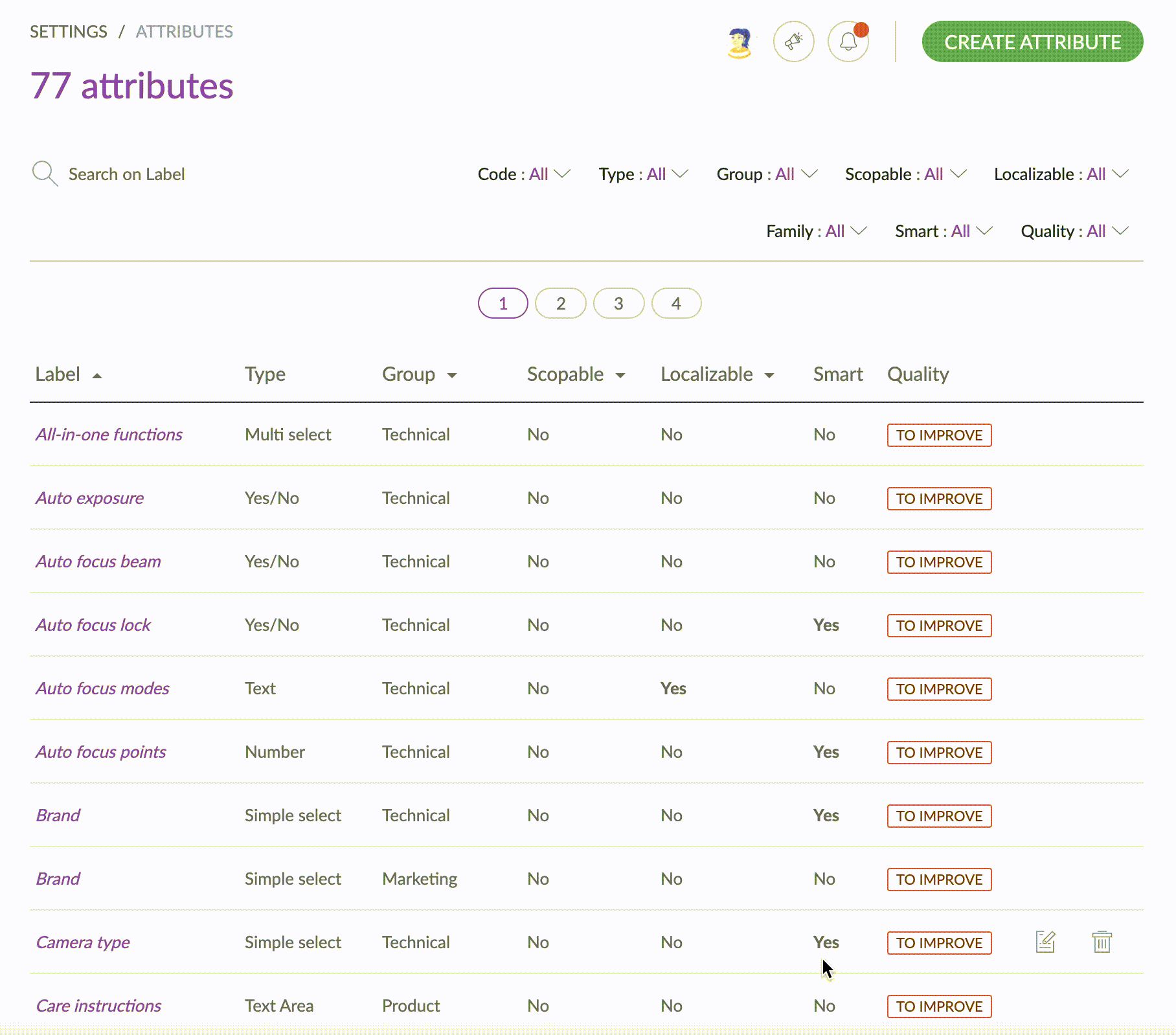
- Change the properties and click on Save
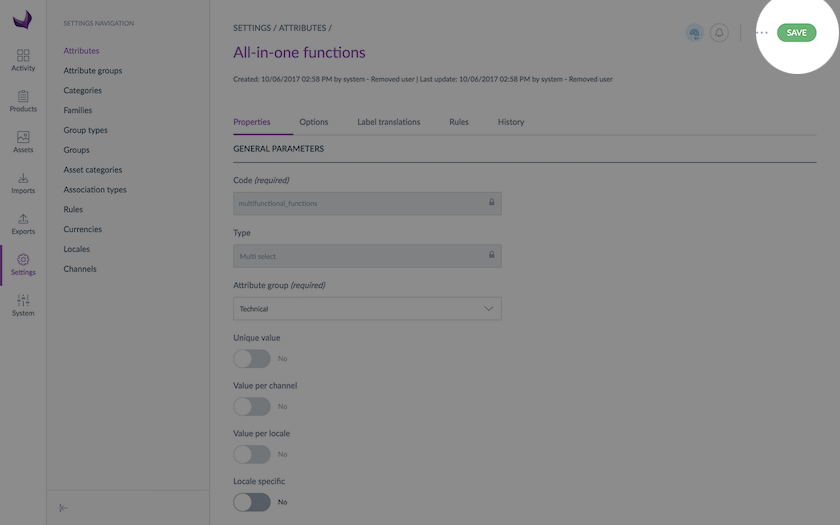
You can change the following properties of an attribute:
- Attribute group: the attribute group the attribute belongs to
- Labels: these are labels that appear when they are displayed in the PIM
- Locale specific: if it must apply to specific locales not all of them
- Usable in grid: whether or not the attribute can be displayed as a column or used as a filter in the product grid (Community and Enterprise Edition) or in the proposal grid (Enterprise Edition only)
- Read only: when enabled it prevents this attribute from being edited in the UI, it can only be updated through imports or rules (Enterprise Edition only)
- Validation parameters (see Add attributes validation parameters)
- Options (for simple or multi select attribute types only): these are predefined values that the user can select
Find your attributes
Go to Settings/Attributes, to see all the existing attributes or create a new one.
The attribute grid displays 25 attributes per page. To browse attributes pages, click on the page number you want to reach or use the filters.
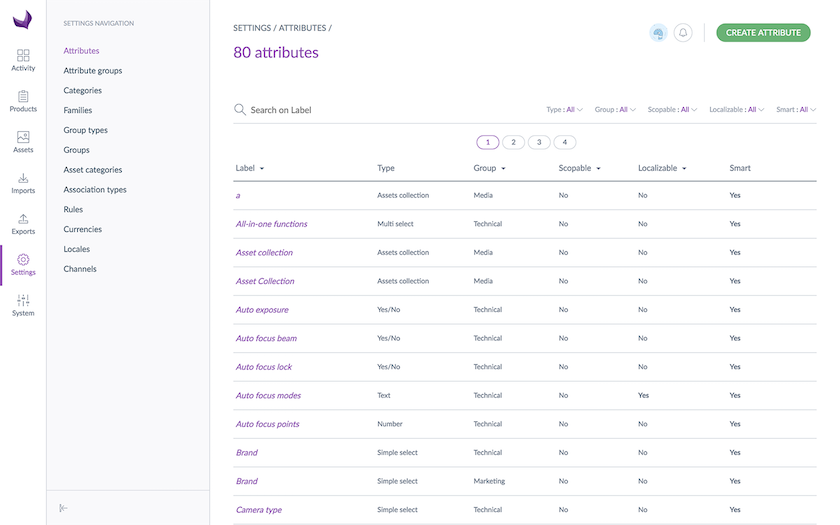
You can sort out attributes by clicking on the column header on the grid.
Search on the grid
ON ITS LABEL
To quickly find an attribute, use the search bar available above the grid. Use your attributes label to find what you are looking for.
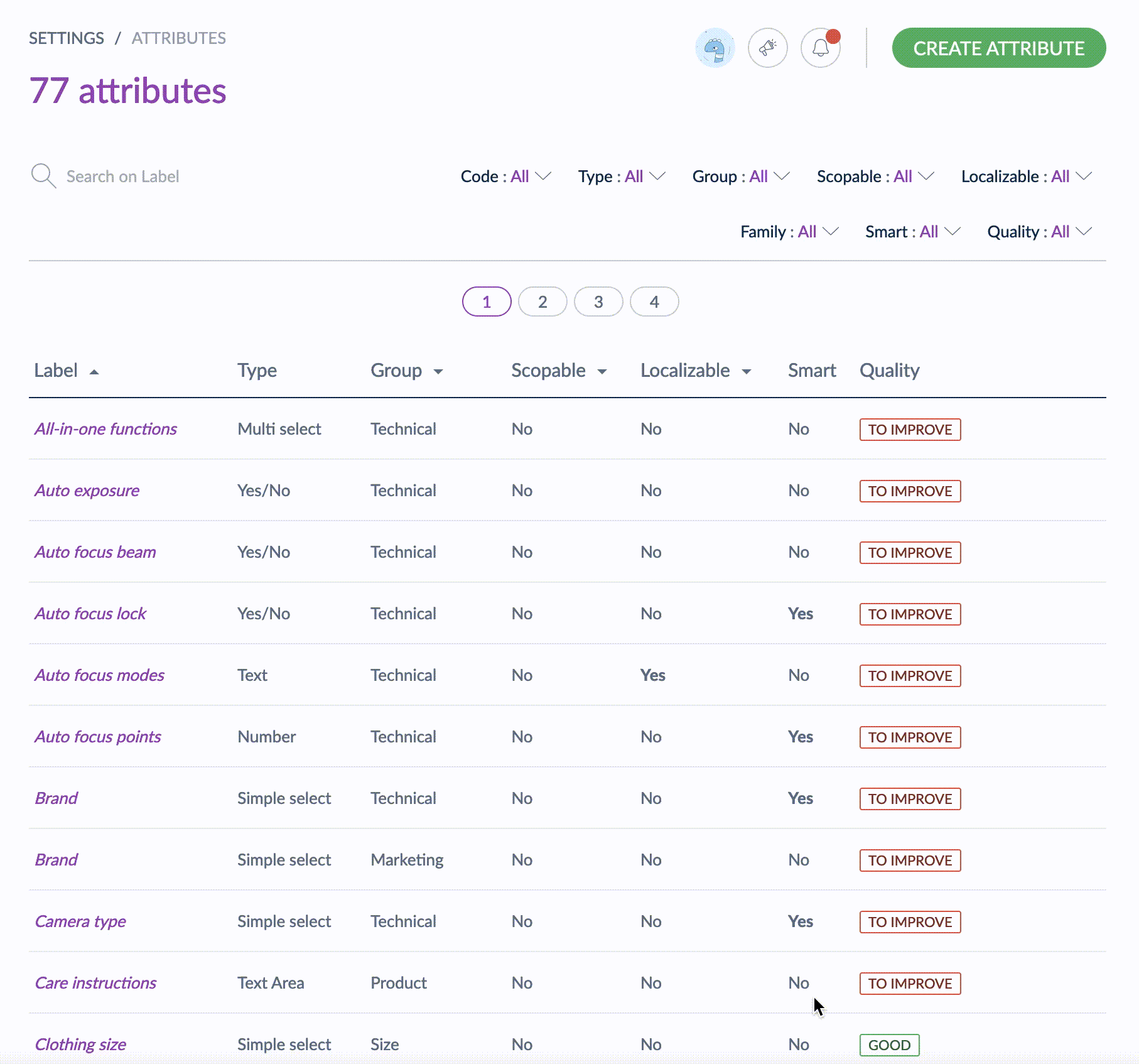
If your attribute does not have any label translated, it will not pop in the search results. Make sure your attribute has its labels translated.
USE FILTERS
Other filters are available on the right side of the screen, you can search attributes based on their code, type...
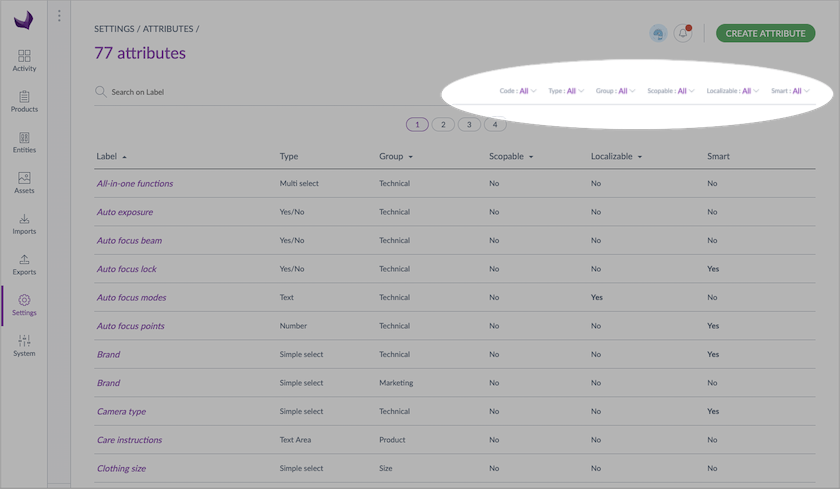
- Enter your filter criteria
- The grid is automatically updated when a new filter is set
You can filter on the following attribute information:
- The attribute code
- The attribute type
- The attribute group it belongs to
- The family it belongs to
- The scopable property (one value per channel)
- The localizable property (one value per locale)
- The smart property (Yes/No) if there is a rule impacting this attribute (Enterprise Edition only)
- The quality status (Good/To improve) if there are spelling typos to correct (Enterprise Edition only)
By default, attributes will be displayed in the catalog locale selected in the product grid. If an attribute code appears into brackets like [color], it means it has not been translated into the current locale.
Shortcut actions on each attribute
There is a set of actions available for each attribute. You can find on the right side of the grid. Buttons are visible when you hover your mouse over the line.
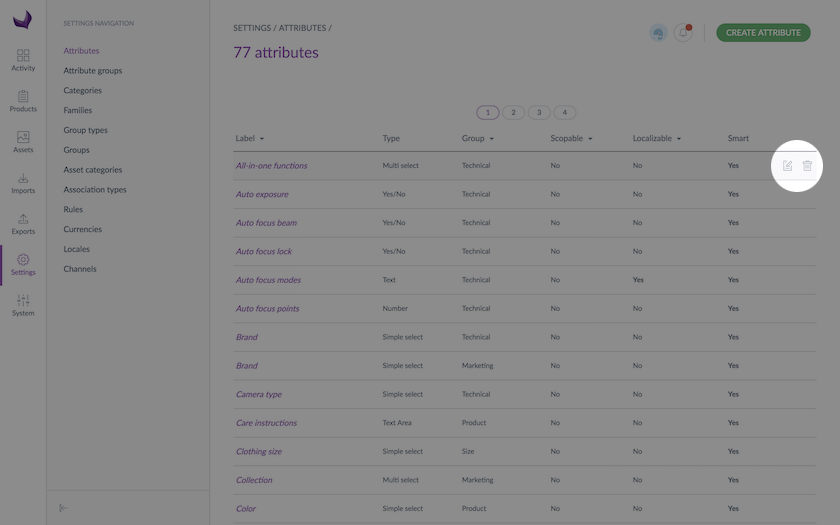
The shortcut actions are only displayed if you have been granted the appropriate rights. Please refer to Manage your user roles to learn more about roles.
Manage simple and multi selects attribute options
You can define option values for simple and multi select attribute types. Options can be added, edited, sorted or deleted.
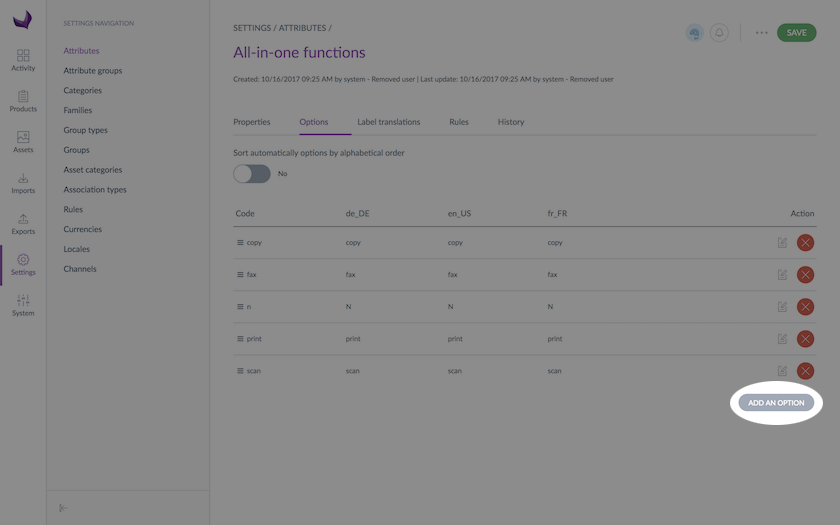
Find the attribute options
To manage your simple and multi selects attribute options, remove an option or add a new one:
- Go to Settings/Attributes
- Select the attribute to edit, then click on the relevant row in the attribute datagrid
- Click on the Options tab
Add a new option
- Click on Add an option button
- Give a unique code to the new option
- Click on the green checkmark at the end of the option line to confirm the creation or on the cross to cancel the option's creation.
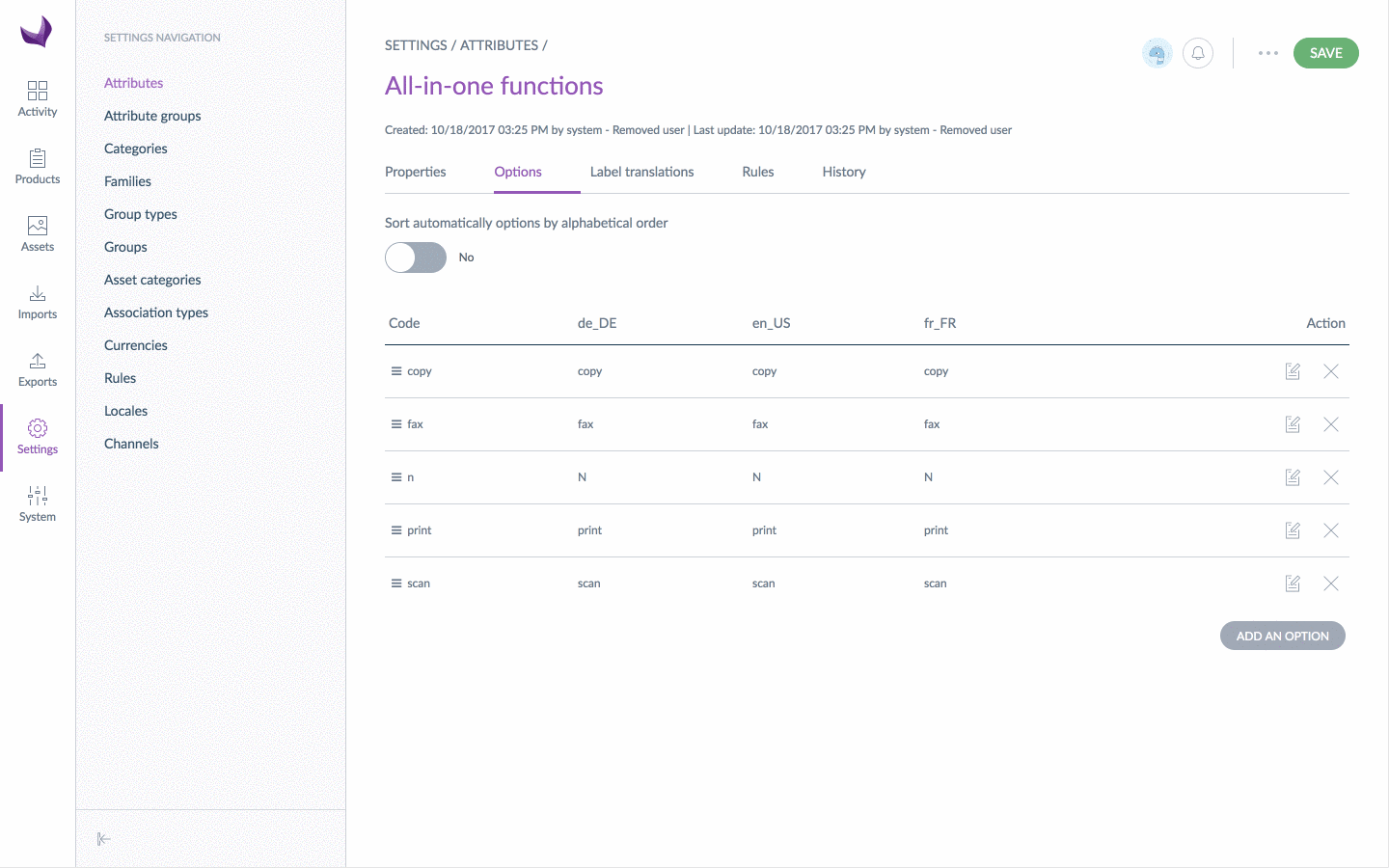
The option is instantly created.
You can add and update many lines at once but you will have to save each line before leaving the page. You cannot use the main Save button to record your new options.
Edit option labels
- Click on the small pencil icon change the option label(s)
- Click on the green checkmark to confirm or on the cross to cancel
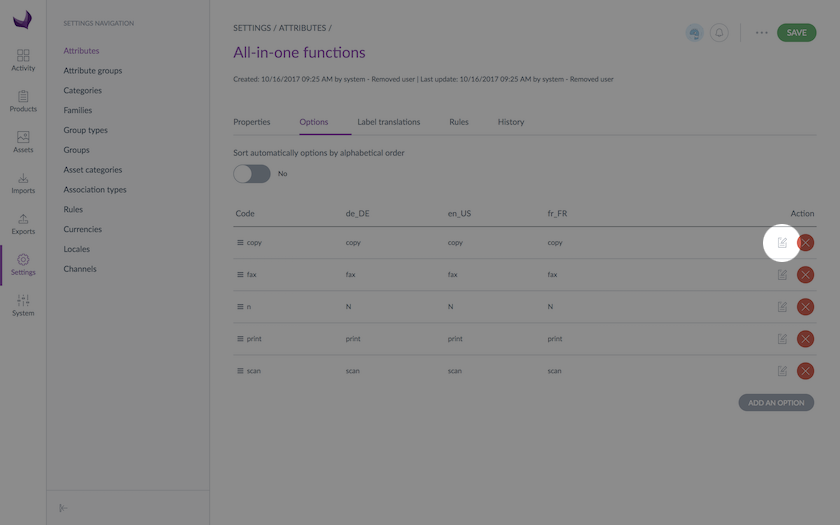
Delete an option
Click on the Delete button to remove an option
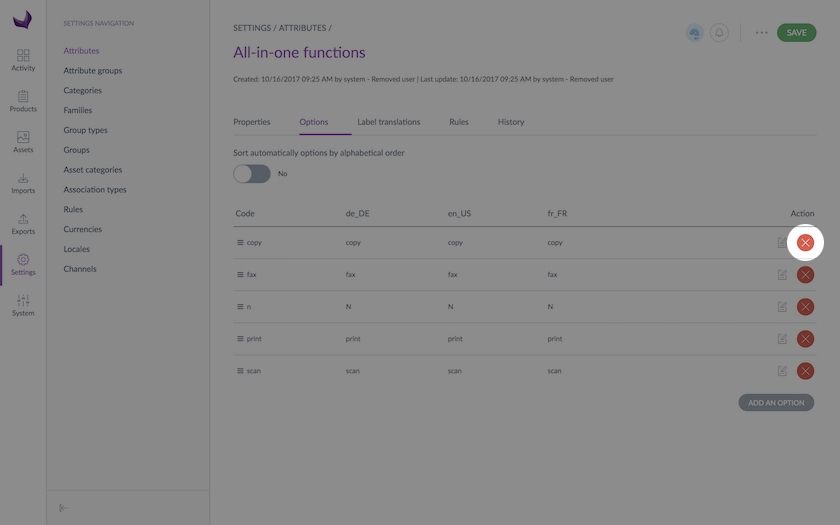
A deleted option can no longer be used as a value for the attribute of a product. If a product had this value, it will be removed from the product's attribute.
If an attribute option is used in a variant product or a product model as a variant axis value, the option cannot be removed, an error message will be displayed. Please refer to the what is a family variant article for more details about variant axes.
An option that is used by a published product cannot be deleted. Unpublish the product to be able to delete the option.
Sort options
Options can be automatically sorted by alphabetical order using the toggle button Sort automatically options by alphabetical order on the top of the attribute's options page.
If you want to define your own sort, you can drag and drop option rows to reorder options manually.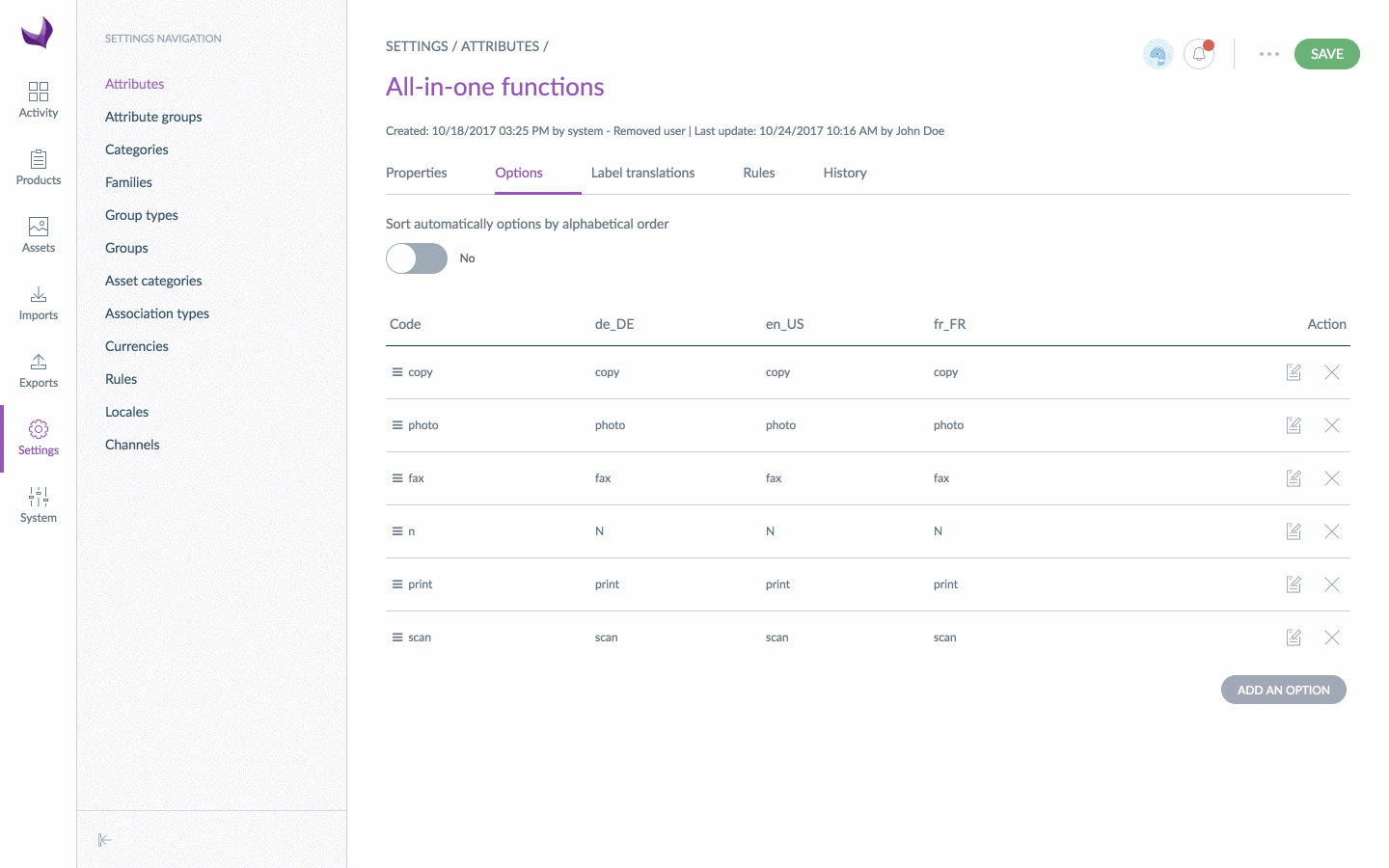
Manage rules on attributes (EE only)
If you are not familiar with the concept of rules, you can read our What is a rule? article.
If a rule applies to your attribute, this rule will be visible under the Rules tab.
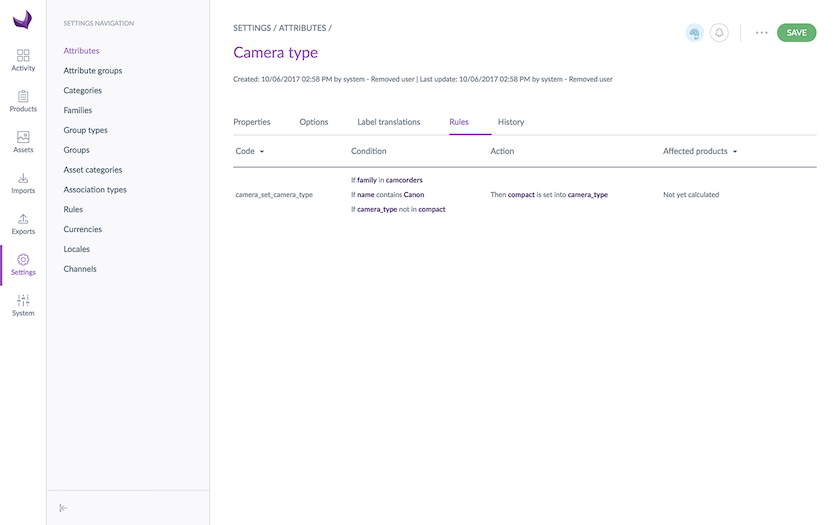
The Rules screen is composed of several information:
- Rule's code: the name of the rule imported
- Rule's condition(s): the conditions to apply the rule, starting with “If”
- Rule’s action(s): the actions to do if the product matches the condition(s), starting with “Then”
- Number of affected products (if calculated): the number of products that are impacted by the rule (this calculation can be run from the Settings/Rules page, see the dedicated section Calculate the number of affected products for rules.
The rules have to be read from left to right: conditions and then actions.
Like on the Settings/Rules page, you can execute or delete rules from the Rules tab.
All active rules can be seen from the Settings/Rules page. See our Get started with the rules engine to learn every thing about rules.
Check the attribute history
All changes made on attributes are saved and visible under the attribute’s history, for example: a label change, a property change, etc.
For each change, an attribute version is created. The following information is tracked down for each version:
- The person or system that made the changes
- The date and time (up to seconds) of the changes
- The old value and the new value of each modified field
To view the attribute versions:
- Open and edit the attribute page
- Click on the History tab and the list of version will be displayed
Unlike products you cannot restore or revert an attribute’s version.
Delete an attribute
Please first delete your attribute from the families it is used in and then from the products. After this, you will be able to delete safely your attribute.
There are two ways to remove an attribute:
Through the attribute edit form:
- Select the attribute to delete
- Click on ... for other actions and then Delete on the top right corner
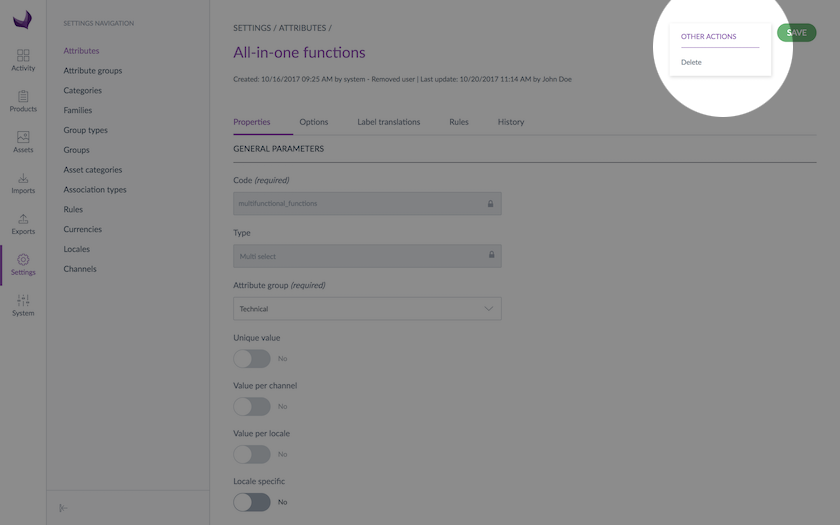
- Confirm the action in the popin
Through the Delete shortcut in the grid:
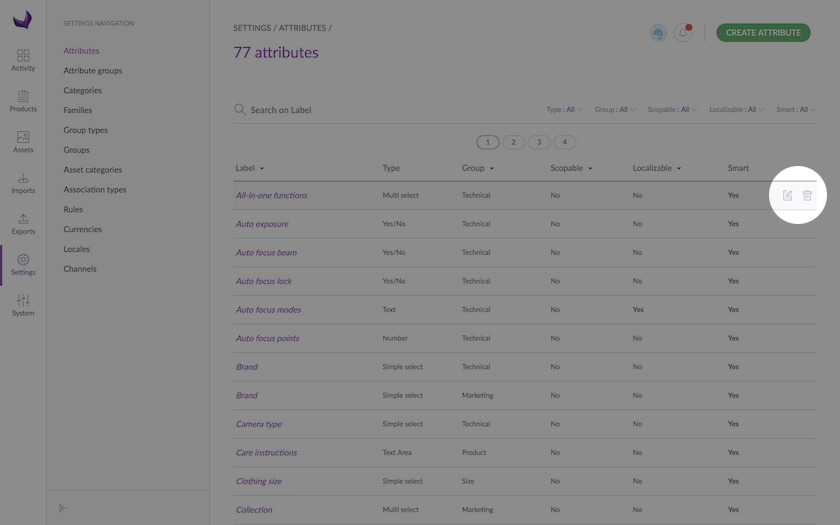
- Select the attribute you want to remove from the attribute grid
- Place your mouse over the line of attribute in the grid, the button Delete is prompted (trash can icon)
- Click on the trash can icon
- Confirm the action in the popin
The attribute and all its relevant information will be deleted in Akeneo PIM. Once you have confirmed the action, it cannot be reverted.
An attribute that is used in a published product cannot be deleted. You first need to unpublish the product(s) and then delete the attribute.
If you cannot access the attribute page or if you cannot add/delete an attribute, it is probably because you do not have the permission to. Please refer to Manage your user roles to learn about roles.

